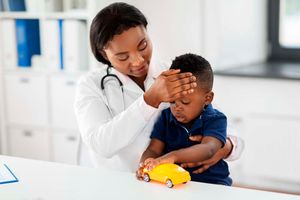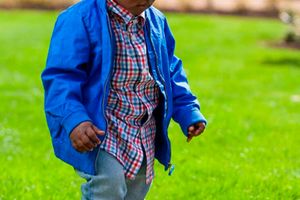Pneumonia disease burden in Kenya: How to protect your children

WHO recommends the use of antibiotics prescribed by a qualified health professionals for mild cases of pneumonia
What you need to know:
- Viruses and bacteria that are commonly found in a child's nose or throat can infect the lungs if they are inhaled.
- Symptoms of pneumonia vary according to the cause.
Pneumonia is one of the most highly reported disease incidents in Kenya. Between 2017 and 2021, health data from the Economic Survey 2022 shows that a total of 8,668,911 cases were reported and recorded in health facilities across the country. The highest number of pneumonia cases in the five years on record was in 2021 when a total of 2,152,687 cases of pneumonia were reported at health facilities. These high numbers of infections trigger high numbers of deaths due to pneumonia.
Over the past few years, pneumonia has been a top killer of children. For instance, data from the Global Burden of Diseases shows that in 2016, Kenya lost 11,203 children aged five years and below to pneumonia. Also, according to the UNICEF and Save the Children report on pneumonia dubbed ‘Fighting for Breath in Kenya’, 9,000 children under the age of five years succumbed to pneumonia in Kenya in 2018. This represented an average of 24 child pneumonia deaths every day. Some counties in Kenya are more affected by pneumonia than others.
In Homa Bay County, for example, children are five times more likely to die before the age of five. This is because the mortality rate is 119 per 1,000 live births. Globally, the 2018/19 pneumonia data by the United Nations Children’s Fund (UNICEF) shows that one child succumbs to pneumonia after every 39 seconds. This is echoed by the World Health Organization which states that as of 2019, pneumonia killed 740,180 children under the age of 5 in 2019. This accounted for 14 percent of all deaths of children under five years and 22 percent of all deaths in children aged 1 to 5. “Pneumonia is the single largest infectious cause of death in children worldwide,” the WHO states.
What is pneumonia?
According to the World Health Organization, pneumonia is a form of acute respiratory infection that affects the lungs. “The lungs are made up of small sacs called alveoli, which fill with air when a healthy person breathes. When an individual has pneumonia, the alveoli are filled with pus and fluid, which makes breathing painful and limits oxygen intake,” the WHO cites. Although this disease is more lethal in children, it can cause mild to severe illness in people of all ages.
Causes
There are three primary causes of pneumonia: viruses, bacteria and fungi. Out of these, the most common cause is Streptococcus pneumoniae. “This is the most common cause of bacterial pneumonia in children,” cites the WHO. “Haemophilus influenzae type b (Hib) is the second most common cause of bacterial pneumonia.” The WHO also states that the respiratory syncytial virus is the most common viral cause of pneumonia. “In infants infected with HIV, Pneumocystis jiroveci is one of the most common causes of pneumonia, responsible for at least one-quarter of all pneumonia deaths in HIV-infected infants,” the WHO states.
Transmission
According to the WHO, viruses and bacteria that are commonly found in a child's nose or throat can infect the lungs if they are inhaled. “It also spread via air-borne droplets from a cough or sneeze. At the same time, it may also spread through blood, especially during and shortly after birth,” the WHO adds. According to the Centre for Disease Control, the bacteria and viruses that most commonly cause pneumonia in the community are different from those in healthcare settings.
- Community-acquired pneumonia: This is when an individual develops pneumonia in the community setting.
- Healthcare-associated pneumonia: This is when an individual develops pneumonia during or following a stay in a healthcare facility.
- Ventilator-associated pneumonia: This is when an individual develops pneumonia after being put on a ventilator.
Symptoms
Symptoms of pneumonia vary according to the cause. For example, an individual who has viral pneumonia may exhibit more symptoms that an individual who has bacterial pneumonia. If you have a child under the age of five years, the WHO says that you should seek medical attention immediately if your baby has a cough, difficulty breathing, fast breathing, wheezing, and lower chest wall in-drawing. This is regardless of whether they have or don’t have a fever. “The chest moving in or retracting during inhalation is a sign of the presence of pneumonia. In a healthy individual, the chest expands during inhalation. Very severely ill babies may be unable to feed or drink and may also experience unconsciousness, hypothermia, and convulsions,” cites the WHO.
Prevention and Treatment
According to the CDC, it is important to have your baby vaccinated against pneumonia. “Vaccines can help prevent infection by some of the bacteria and viruses that can cause pneumonia,” the CDC states. According to the Kenya Expanded Programme on Immunization Schedule, the pneumococcal vaccine (PCV 10) should be administered in babies at weeks 6, 10, and 14. This vaccine is administered on the right outer thigh at a dosage of 0.5mls and protects against the bacteria Streptococcus pneumoniae which is the most common cause of bacterial pneumonia in children. Incidentally, by 2010, Kenya did not have a pneumococcal vaccine in the national childhood immunization schedule. The country introduced the PCV 10 (also known as Synflorix) vaccine which is tailor-made to protect against 10 common strains of S. pneumonia in 2011. When treating pneumonia, the WHO recommends the use of antibiotics prescribed by a qualified health professionals for mild cases of pneumonia, and hospitalisation for severe cases of pneumonia





